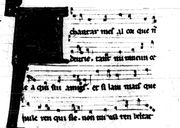Trobairitz
2008/9 Schools Wikipedia Selection. Related subjects: General history; Musical genres, styles, eras and events
The trobairitz (IPA: [tɾuβajˈɾits]) were Occitan female troubadours of the 12th and 13th centuries. The word trobairitz was first used in the 13th-century romance Flamenca. It comes from the Provençal word trobar, the literal meaning of which is "to find", and the technical meaning of which is "to compose". Trobairitz composed, wrote verses, and performed for the Occitan noble courts. They are exceptional in musical history as the first known female composers of Western secular music; all earlier known female composers wrote sacred music. The trobairitz were part of courtly society, as opposed to their lower class counterparts the joglaresse. Although troubadours frequently came from humble origins— Bernart de Ventadorn may have been the son of a castle's baker— the trobairitz were nobly born. The most important trobairitz are Alamanda de Castelnau, Azalais de Porcairagues, Maria de Ventadorn, Tibors, Castelloza, Garsenda de Proença, Gormonda de Monpeslier, and the Comtessa de Diá.
Position in medieval society
Throughout the 13th century, among the accomplishments necessary for a woman at court were the ability to sing, play instruments, and write jocs partis, or partimen (a debate or dialogue in the form of a poem). The cultivation of these womanly skills may have led to the writings of the trobairitz.
The trobairitz may also have been a result of the power women held in southern France during the 12th and 13th centuries. Women had far more control over land ownership, and Occitan society was far more accepting of women than were other societies of the time. During the Crusades many men were away, which left women with more administrative responsibility, and thus power. Nevertheless, this society was not "feminist", nor was fin' amor, which exalted women while at the same time circumscribing many aspects of their lives and behaviour.
There is difficulty in labeling the trobairitz as either amateurs or professionals. The distinction between these two roles was complicated in the medieval era, since professionals were generally lower class, and amateurs had as much time as professionals to devote to their craft. Joglaresse were lower class, professional composers far less respected than the trobairitz.
Both troubadours and trobairitz wrote of fin' amors, or courtly love. Women were generally the subject of the writings of troubadours, however: "No other group of poets give women so exalted a definition within so tightly circumscribed a context of female suppression." The tension between the suppression of women present in the poetry of the troubadours and similar themes in the poetry of the trobairitz is a major source of discussion for modern commentators. The trobairitz wrote in the canso (strophic song) and tenso (debate poem) genres.
Attribution
The number of works attributed to the trobairitz ranges from 23 to 46. There are a number of reasons for this. In the courtly love tradition it was common for poems to be written as an exchange of letters, or a debate, as in a tenso. Some of these may have been originally written by one poet; however, some were originally an actual exchange of epistles, later gathered together in a manuscript. Some of these were between men, and some were between a man and a woman. Some modern editors attribute these solely to the man who originated the exchange, and some attribute them to both the man and the woman involved. There is a long history of attributing these solely to men, even when all evidence points to the contrary.
Since poetry was highly stylized, it is difficult to determine when a poet speaking as a woman actually was a woman, or a man speaking as a woman. This adds to the difficulty of attribution, especially of anonymous writers. There is some debate as to whether or not the poems by the trobairitz represent genuine feminine voices, since they worked within the highly circumscribed conventions of the troubadours. Bruckner suggests that the trobairitz "spoke in her own voice as channeled through the voices of many others". By manipulating the strict constructs of troubadour lyric, the trobairitz were able to create their own "fictions of the female voice".
There is one notable instance where clear attribution is given to a woman, Bieiris de Romans (also given as Beatritz), but the subject of the poem is another woman, Na Maria. In the poem "Na Maria" Beatritz expresses her love for Maria in the traditional fin' amors style, both in terms of physical longing and courtly admiration. This poem, if not clearly marked as by a woman, would be assumed to be by a man.
List of trobairitz works
Anonymous
- Bona domna, un conseill vos deman
Attributed
- Alais Iselda and Carenza: Na Carenza al bel cors avinen
- Alamanda de Castelnau
- Almucs de Castelnau and Iseut de Capio: Domna n’Almucs, si-us plages
- Azalais d'Altier
- Azalais de Porcairagues
- Beatriz de Diá
- Castelloza
- Clara d'Anduza
- Beatritz de Romans: Na Maria, pretz e fina valors
- Felipa
- Garsenda de Proença: Vos qe’m semblatz dels corals amadors
- Gaudairença: Coblas e dansas (not extant)
- Gormonda de Monpeslier
- Guillelma de Rosers
- Domna H.
- Lambarda
- Maria de Ventadorn: Gui d'Uisel, be.m pesa de vos
- Tibors de Sarenom
- Ysabella

